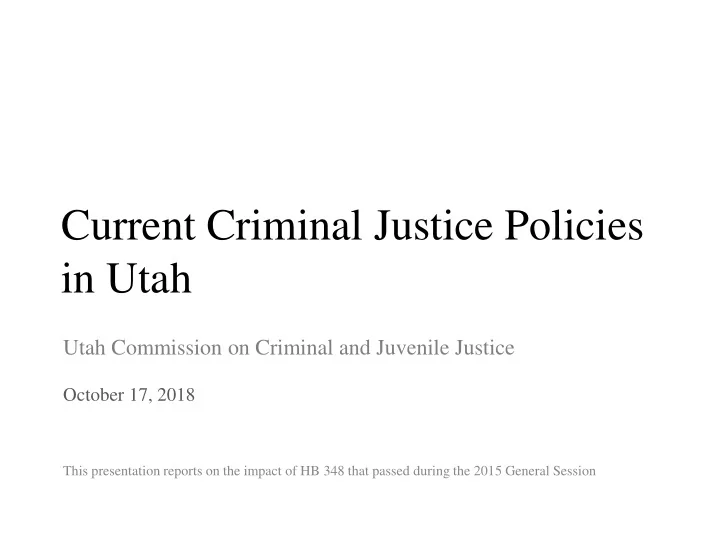

Current Criminal Justice Policies in Utah Utah Commission on Criminal and Juvenile Justice October 17, 2018 This presentation reports on the impact of HB 348 that passed during the 2015 General Session
Eco-system map
In 2013.. • 40 percent of prison inmates were serving time for a non-violent offense • Nearly 2/3 of inmates released from prison to parole returned to prison within 3 years, & • There was a significant gap in the availability of substance use and mental health treatment for those offenders in need
Philosophy • Focus prison beds on serious and violent offenders • Strengthen probation and parole supervision • Improve and expand re-entry and treatment services • Match resources to offender's needs • Support local corrections systems, & • Ensure oversight and accountability
Policy recommendation: Focus prison beds on serious and violent offenders
Figure 1. The percent of the prison population that is non-violent Revocation caps continues to reduce parole and probation 33% revocation prison length of stay. Figure 2. Prison length of stay by type The share of the prison population that is non-violent declined the first years of implementation, numbers remain similar between 2017 and 2018.
Figure 3. Net prison admissions While remaining below pre- reform levels, the prison population can be seen trending above the “with reform” line. Figure 4. Actual prison population versus projected with and without reform Admissions to prison is exceeding Without reform prison releases, causing an Actual increase in the prison population. With reform
Policy recommendation: Strengthen probation and parole supervision
Figure 5. Overall probation population Class A probationers make up a larger percent of the probation 13,073 population, implying that the system is focusing its resources on those who are of high risk to reoffend. Figure 6. Class A probationers 3,365 The overall probation population increased similarly before and after current criminal justice policies.
Figure 7. Parole population 4,007
1-year Parole Outcomes • Outcome variables • Control variables – technical violation – age – new conviction – gender – race/ethnicity – marital status – violent offense – offense severity – first parole start – risk to re-offend
Technical Violations Figure 8. Percent expected to be revoked on a technical violation by parole type Previous parole violators are continuing to cycle through the system. Figure 9. Percent expected to be revoked on a technical violation by cohort Overall, parolees on their first parole start are less likely to be revoked than those serving their second or more start.
Technical Violations Cont. Figure 10. Percent expected to be revoked on a technical violation: First parole starts only When restricting the analysis to those serving their first parole start, there is no difference in the likelihood of being revoked on a technical violation across groups.
New Convictions Figure 11. Percent expected to be revoked on a new conviction The percent of new convictions that are violent has declined post- reform. Figure 12. Percent of new convictions that are violent There is an increased likelihood of being revoked on a new conviction in the second post- reform period.
• Findings hint at; – Increased need of effective interventions for previous parole violators – Examining fidelity & current capacity to fully implement reform policies – Look at current enforcement practices – Understanding findings in context to general health trends • Nation-wide Opioid epidemic
Policy recommendations: Match resources to offender's needs & Support local corrections systems
Risk and Needs Jail Screening Process • Half of Utah’s offender Figure 13. Percent in need of substance use population* is in need of a referrals by county substance use referral • 40 percent are in need of a mental health referral Percent • One third screen positive for a possible co-occurring disorder, and • Close to 70 percent of offenders are moderate or high risk to reoffend *Includes those booked on a Class B Misdemeanor and above.
Policy recommendation: Improve and expand re-entry and treatment services
Figure 14. Number of justice involved clients served for substance use treatment Admissions to residential treatment alone increased 38 percent during 12,842 this time-period. Table 1. Admissions to substance use treatment by level Level of service Pre-annual ave. Post-annual ave. % change Residential 964 1,328 38% The number of clients served for substance use treatment in Intensive Outpatient 3,108 3,224 4% Utah’s public behavioral Outpatient 8,155 8,222 1% health system is increasing. Detox 841 1,126 34%
Ongoing Efforts • Promising initiatives • Importance of – Women’s improvement implementation science network initiative – (e.g., assuring fidelity around – Project freedom new supervision policies) – Washington County pilot – quality of treatment program
Policy recommendation: Ensure oversight and accountability
Next Steps • For CCJJ – Closer look at parole revocations – Probation outcomes – Evaluation of current treatment standards • For the system as a whole – Implementation with fidelity – Organizational capacity – Increased data sharing
Thank you Questions about this presentation may be directed to: kimcordova@utah.gov or snystrom@utah.gov
Recommend
More recommend